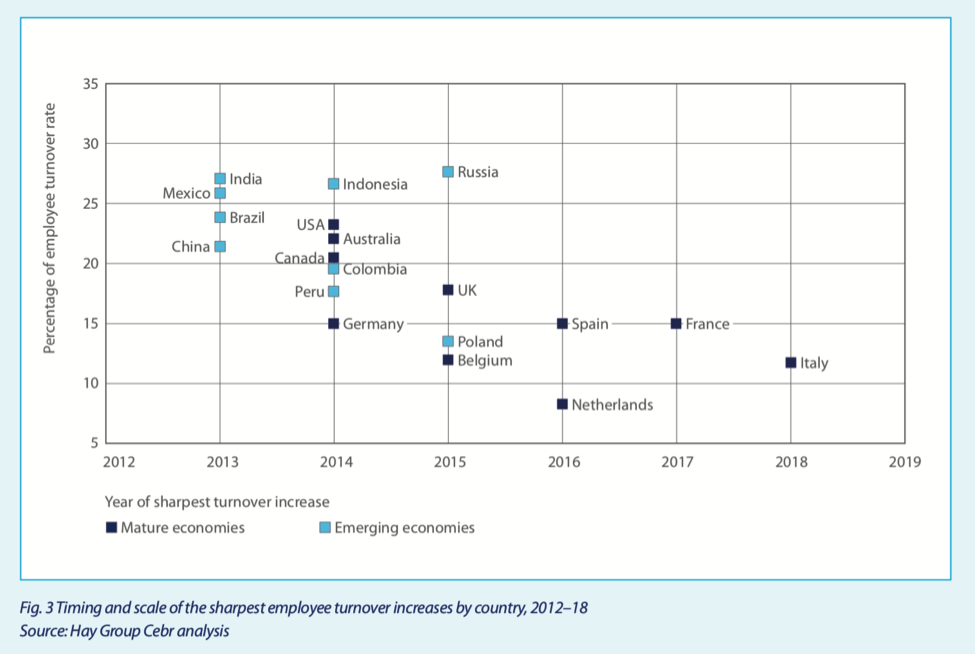In 2018, about three out of four employees will be leaving their current job for a new one. The majority of these only stayed about six months with their current company.

Source: Harvard Business Review
It’s true that your HR department can find new blood to replace those that left. But, it’s neither easy nor cheap.
Finding qualified applicants to replace those that left takes time. One study shows that it takes an average of 52 days for HR to find a suitable candidate to fill a vacated position.
Second, replacing employees cost significant losses for your company. In the US alone, it’s estimated that the total amount companies lose because of employee turnover is $536 billion!
The stakes are even higher if you lose a high performing employee. One top-performing employee is 400% more productive than their peers, further impacting your business’ finances and bottom line.
This crisis on employee retention is not a phenomenon affecting just the US. It’s a global epidemic.

Source: Atrium Haygroup
As with any epidemic, the natural—and expected—response is to take action to address this. Most companies try to resolve this by offering candidates impressive salary packages, complete with medical coverage, insurance, and even a retirement plan.
Yet, from the looks of things, this is not enough. In fact, according to a research done by Gallup, only 22% of employees said that their salary is the reason why they are leaving.
Below are five major reasons why employees leave their current job and suggestions on how to properly address them.
1. Employees want to be recognized and appreciated.
“The deepest principle in human nature is the craving to be appreciated.”
66% of employees point to this as their primary reason why they will leave their current job.
It’s not narcissism. Rather, this desire for appreciation and recognition is a fundamental human need.
When your employees start to feel neglected and unappreciated for the work they do, it causes them to become less enthusiastic about their work. Their performance and productivity dwindle. Their self-esteem plummets. Before long, their attention has shifted to looking for opportunities elsewhere.
As a manager or business leader, understand that your employees are among your company’s most valuable assets. So you need to make sure that you make them feel as such.
While giving cash rewards to employees for a job well done is appreciated, there are a lot of cheaper—but meaningful—ways how you can show your employees how much you value them and the work they’re doing in your business. Simply taking the time to stop by their desk to tell them that they’re doing a good job goes a long way to make your employees feel they matter, and stop them from leaving you.
Sending out polls and surveys asking your employees how they feel about their day-to-day work is another. People love it when they can see that their opinion matters, especially when they can see their suggestions are enforced within the company. It shows them that they’re not just valued for the work they do, but for who they are as individuals.
2. There’s no room for personal growth.
According to a survey done by Express Employment Professionals, 40% of employees said that they will consider leaving a company when their work has become routine and there’s no opportunity for them to grow.
In contrast, another study shows that 20% of employees said that a change in their work responsibilities and duties will stop them from leaving while 74% of employees will stay in their work starts become interesting again.
If you want to stop your employees from leaving you, make sure that you provide them with opportunities to advance themselves and grow in their chosen field.
One way of doing this is by helping them develop their own online personal brand through employee advocacy.
Email advocacy is a social media marketing strategy where your employees serve as your company’s brand advocates and ambassadors. By publishing posts about your company on their social media accounts, your employees have now become your in-house brand ambassadors enabling you to build brand awareness and increase your social media marketing ROI.
Encouraging your employees to take part in your employee advocacy program will also train them on social media best practices, challenge them to get creative with what they post, and even inject their own personality into what they create.
Eventually, they will develop the skills they need to develop their own personal brand so that they won’t just be recognized as another employee in your company, but as a reputable thought leader and expert in their chosen field.
HubSpot is a great example. Their employees get to share events, meeting, and things that they’re working on Instagram using the hashtag #hubspotemployeetakeover.

Source: Screenshots from #hubspotemployeetakeover
Offering your employees certification courses and training opportunities is another way to show them that you value their growth as individuals. Websites like Lynda and Udemy offer an array of certifications and short courses that your employees can complete at their own pace online at affordable prices.
3. Having a hostile working environment.
Detoxification has become a buzzword when it comes to health and wellness because of studies showing how toxins in the body cause a variety of illnesses and disease.
The same thing holds true in the workplace. Toxic behaviors such as gossip, bullying, and harassment can suck the enthusiasm and life from your employees, resulting in poor work performance, disengagement, and even experience stress-related illnesses and health conditions. Prolonged exposure to a work environment where managers and leaders turn a blind eye and a deaf ear to these can be more than enough reason for employees to run for the hills and leave your company without looking back.
People want to feel safe, including in the workplace. As a manager, it’s your responsibility to take action against these toxic behaviors as soon as possible. Implementing proper guidelines and procedures for employees victimized by these toxic behaviors to report these incidents without fearing retaliation is one way of doing this.
Another is by enforcing an “open-door policy” within your workplace. According to Ronnie Wilson, CEO of SaveOnIT, having an open-door policy within your workplace is one of the best ways to prevent toxic situations from spreading for as long as it’s done right.
“Making yourself available to listen to your employees is only the first step, especially when they’re coming to you to report a concern or issue they’re having with their co-employees,” he said. “You need to act on them like you promised. If they gave you a suggestion and you promised that you’ll run it by your superiors, do it. If they report that one of their co-employees is giving them a hard time, investigate it further. Only then will having an open-door policy help make your workplace a safer and more enjoyable environment for everyone.”
4. Managers that love to micromanage.
Would you enjoy having someone literally looking over your shoulder and giving you a comment on each and every single thing you do at work? Well, neither would your employees.
Yet, in a study done by Accountemps, 59% of employees said that they have worked with a manager that micromanage at least once.
So why do many managers micromanage their employees? Well, it boils down to fear.
Managers are only as good as the employees on their team. They’re afraid that unless they keep a close eye on the work each one does, either the work will never get done or it would not be up to the standard expected by the company.
It’s true that micromanaging can be beneficial in certain scenarios like if you have a new hire joining your team or when one of your employees is struggling to complete assigned tasks. However, an effective manager should know when it’s time to let go of the reins and trust your employees that they will be able to get the job done.
That might sound like an awfully big risk, however, it will be well worth it. When you show your employees that you not only recognize their abilities but also trust in their capabilities, this will help boost their morale and confidence. In turn, it will not only increase their productivity but also convince them to stay.
5. Rigid working conditions.
Competition among businesses within any given industry has now become extremely fierce. Because of this, hustling has become the norm for many companies at their employees’ expense.
Sure, it’s normal to expect that your employees to work long hours every now and then. But you also need to give them the opportunity to decompress, rest, and recharge if you want them to stay productive and not get too burned out that they decide to leave.
One way to do this is by providing your employees with meditation tools that will allow them to reduce their stress levels and regain their focus while at work. You can even hold a group session for your employees within the office. Not only will this help increase their productivity and lessen their stress levels, but also build camaraderie among your employees.
Another is to offer telecommuting and flexible work schedules for your employees. Technology today has now made it possible for employees to do their jobs even when they’re not in the office. In fact, 63% of employees firmly believe that they don’t need to be at their office desk to get their jobs done. Giving your employees the ability to have a flexible schedule and the option to work where they are most comfortable means that they’re more able to balance their time between work and their families.
Ultimately, the main reason why employees leave a company is that they feel that their personal needs are not met. As a manager or business leader, you’ll need to be able to pinpoint what these needs are, and find ways that will effectively address these without compromising your company’s resources. The more that you’ll be able to do this, the more that you’ll become successful in stopping employees from leaving, and even transform your company into one where people would love to work.


